Hybrid app development is one of the hottest trends in the tech industry. In recent years, we have seen its popularity grow at a rapid speed. Given that the hybrid approach dramatically accelerates the development process while reducing its cost, such interest around it should come as no surprise.
You see, with hybrid development you can create your application once and then deploy it across different operating systems, be it Android, iOS, Windows Phone, or Windows. In other words, you don’t need to write separate app codes for each individual platform. Instead, you write it only once and then reuse it when building the app for each target OS. That way you significantly minimize development costs and can create your product even with a relatively low budget.
Considering the above, we couldn’t resist writing an article on the best and most popular hybrid mobile app frameworks. So let us introduce you to the top 12 frameworks you can utilize right now to create hybrid applications for your business.
#1 Flutter

Flutter is an open-source framework created by Google for building natively compiled, multi-platform hybrid apps from a single codebase. According to a Statista survey, it is currently the most used framework worldwide, along with React Native.
Flutter uses its own programming language called Dart, which is a combination of Java and Kotlin. It has an improved type system and helps developers create highly-productive applications for iOS and Android operating systems with ease. The framework also supports hot reloading, allowing you to make instant changes when debugging code to decrease development time.
Apps built with Flutter: Google Pay, SpaceX, iRobot, eBay Motors, Etsy, Google Ads.
Pros of Flutter
- Flutter is fast because its code compiles to ARM, Intel Machine, and JavaScript code, allowing for high app performance on any device.
- Unlike Ionic, Flutter supports the hot reload feature, enabling developers to update code and instantly see the changes without having to reload the entire app.
- The framework boasts flexibility: you can control virtually every pixel and create fully customized adaptive designs that will look and work as intended on any screen.
- Flutter supports a wide range of libraries and widgets that facilitate development.
- You can find various Flutter App Builders that can help you build app prototypes or entire applications without using a single line of code.
Cons of Flutter
- Flutter uses the not-so-popular Dart language, so it might be challenging to find developers who have experience with it.
- Apps built with Flutter typically take up 40% more space compared to native applications.
- The framework has a limited ecosystem and community support.
#2 React Native
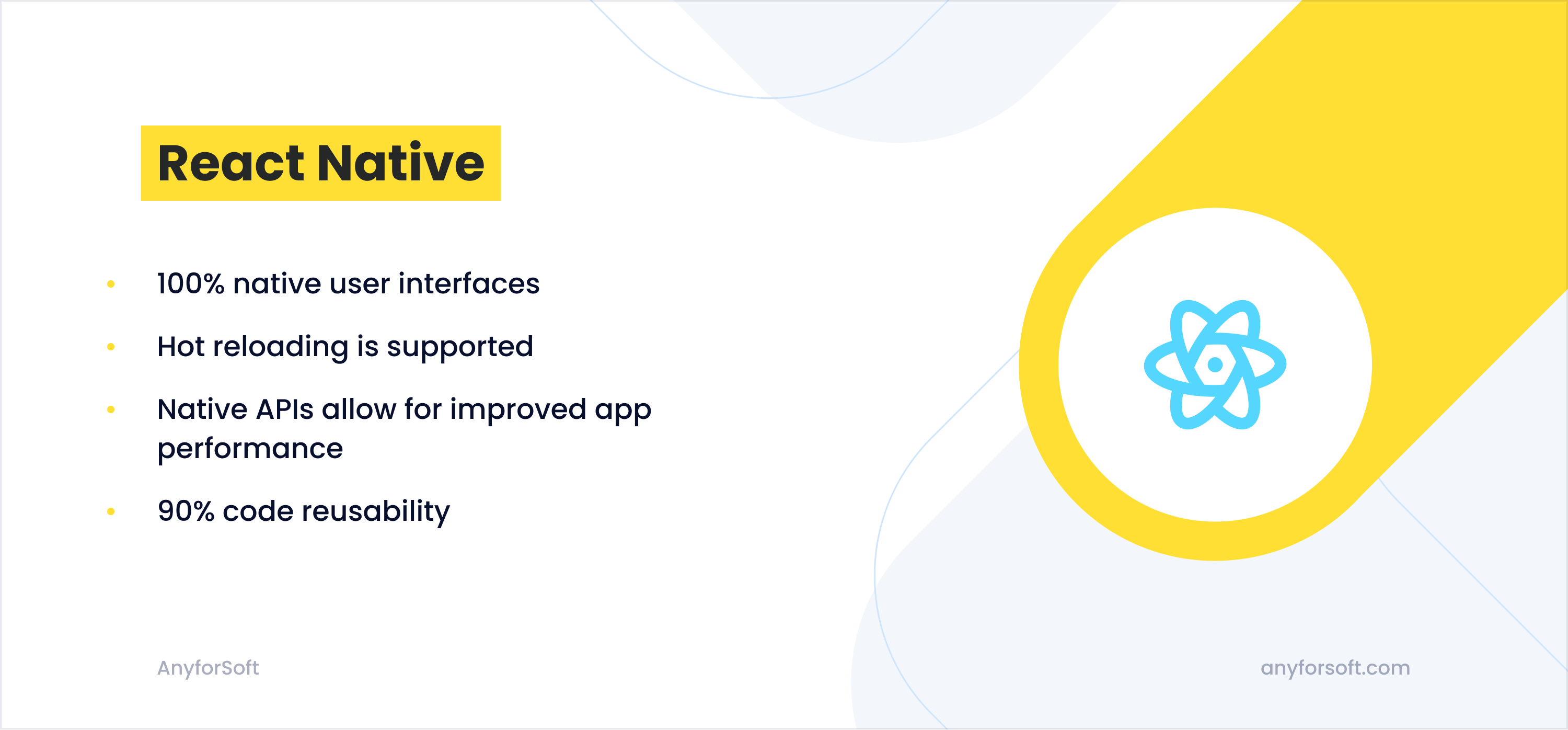
React Native is a hybrid mobile app framework based on JavaScript and designed to create cross-platform mobile apps. The main advantage of this framework is that it allows you to build 100% native user interfaces. With many other hybrid app frameworks (such as Ionic, for one), you get a web application wrapped in a native container. However, in the case of React Native, the UI fully consists of native components. That’s why even seasoned developers often mistake React Native apps for native solutions.
Just like Flutter, React Native supports the hot reloading feature, enabling developers to easily debug mobile applications. What’s more, solutions built with this framework render their user interface elements with native APIs. Consequently, they boast high performance, on par with native Android and iOS apps.
Apps built with React Native: Facebook, Instagram, Bloomberg, Walmart, Airbnb, Tesla, UberEats.
Pros of React Native
- The framework uses native UI components, allowing you to develop hybrid apps with native UIs.
- The hot reloading feature is supported.
- Due to the use of native APIs, the performance of React Native apps is on par with that of native applications.
- React Native is one of the most popular frameworks: it has a large community that can help you resolve issues.
- Almost 90% of the code can be reused, so you can quickly build applications for iOS and Android platforms as well as other app stores.
Cons of React Native
- Updates are challenging.
- React Native might be not the best solution for apps with UI transitions, numerous screens, special effects, etc.
- Many developers complain that the framework lacks custom modules.
- From a developer’s perspective, React Native has a steep learning curve.
#3 Ionic

Ionic is a popular hybrid app framework designed for developing modern cross-platform apps of high quality. It has open-source code and is based on widespread web technologies such as HTML5, CSS, Sass, and JavaScript. Ionic boasts over a hundred native features, including fingerprint authentication, camera, GPS, Bluetooth, HealthKit, and others. It also supports Angular, React, and Vue JavaScript frameworks while having back-end connectors to Firebase, AWS, and Azure.
Using their CLI, you can create, test, and deploy Ionic apps to virtually any platform.
Apps built with Ionic: McDonald’s Turkey, MarketWatch, Shipt, Sworkit, JustWatch, Sanvello.
Pros of Ionic
- The open-source framework Ionic is developer-friendly, allowing developers to create apps for multiple platforms using a single codebase.
- Ionic Framework supports integration with a wide variety of tools and plugins, including payment systems, security tools, analytics software, and so on.
- Ionic allows you to build hybrid mobile apps using any JS framework (Angular, Vue, React) or no framework at all.
- The framework boasts high performance, enabling you to build apps using built-in features such as pre-rendering, touch-optimized gestures, hardware-accelerated transitions, and others.
Cons of Ionic
- Debugging hybrid mobile apps built with Ionic is challenging because the framework sends unclear error messages, making it difficult to determine what causes issues.
- Builds can randomly crash without any apparent reason.
- Native plugins often conflict with each other and cause errors.
- Ionic doesn’t support hot reloading and relies on live reload instead.
#4 Xamarin

Xamarin is a free open-source hybrid app framework owned by Microsoft. Using Xamarin, app developers can build solutions for Android, iOS, tvOS, watchOS, macOS, and Windows platforms with .NET and C#. Just like React Native, the framework offers native API access, allowing for building hybrid mobile apps with native-like performance.
What makes Xamarin unique is that it has a huge library collection, including libraries for Java, C++, and Objective-C.
Apps built with Xamarin: Alaska Airlines, Microsoft Azure, UPS Mobile, FreshDirect, OLO, BBC Good Food.
Pros of Xamarin
- Xamarin allows you to create hybrid apps with a native look and performance.
- All your hybrid app development in one tech stack: no matter what platform you are targeting, you can build a solution using C# and .NET framework and then deploy it across any platform.
- Xamarin offers a vast library collection that facilitates development.
- This hybrid mobile app framework has a full-fledged ecosystem with tools such as Xamarin Test Cloud, Xamarin Studio, Xamarin Insights, and Xamarin SDKs.
Cons of Xamarin
- Xamarin is quite expensive compared to other hybrid app frameworks from this list (its enterprise plan costs $1899 a year).
- Hybrid apps developed with this framework require more storage space compared to native mobile apps (a simple application can be 10+ MB in size).
- You might face compatibility issues with third-party plugins.
#5 Onsen UI

Onsen UI is an open-source hybrid mobile app framework with a vast selection of libraries for the Angular JS 1, Angular 2+, React, and Vue frameworks. It also boasts a rich variety of UI elements designed specifically for mobile operating systems. Namely, Onsen UI offers side menus, tabs, stack navigation, forms, lists, and numerous other components. Each of them supports iOS and Android Material design and applies automatic styling that changes the look of the app depending on what platform it’s opened on.
Overall, Onsen UI is a well-optimized and easy-to-learn hybrid mobile app development framework that can help you create native-like solutions for iOS and Android operating systems.
Apps built with Onsen UI: PopVox, Offcourse Golf, Opal, Petoom, Ohalog, Giro D'Italia.
Pros of Onsen UI
- Onsen UI is a well-optimized for mobile hybrid mobile app development framework that provides a great user experience, with every animation tuned to perform fast on a wide range of devices.
- The framework is easy to learn thanks to the abundance of learning resources the company provides (official documentation, interactive tutorials, and community forum).
- A rich variety of UI components designed specifically for mobile applications allow developers to create hybrid mobile applications with a native-like look and feel.
- Onsen UI offers lots of libraries for the Angular JS 1, Angular 2+, React, and Vue frameworks.
- The framework uses well-known and widespread technologies: CSS, HTML, and JavaScript.
Cons of Onsen UI
- Documentation might seem confusing to some.
- The pricing constantly changes.
- Onsen UI’s component model is not always granular.
- Onsen UI is less popular and widespread compared to other hybrid mobile app development frameworks in this article.
#6 Apache Cordova
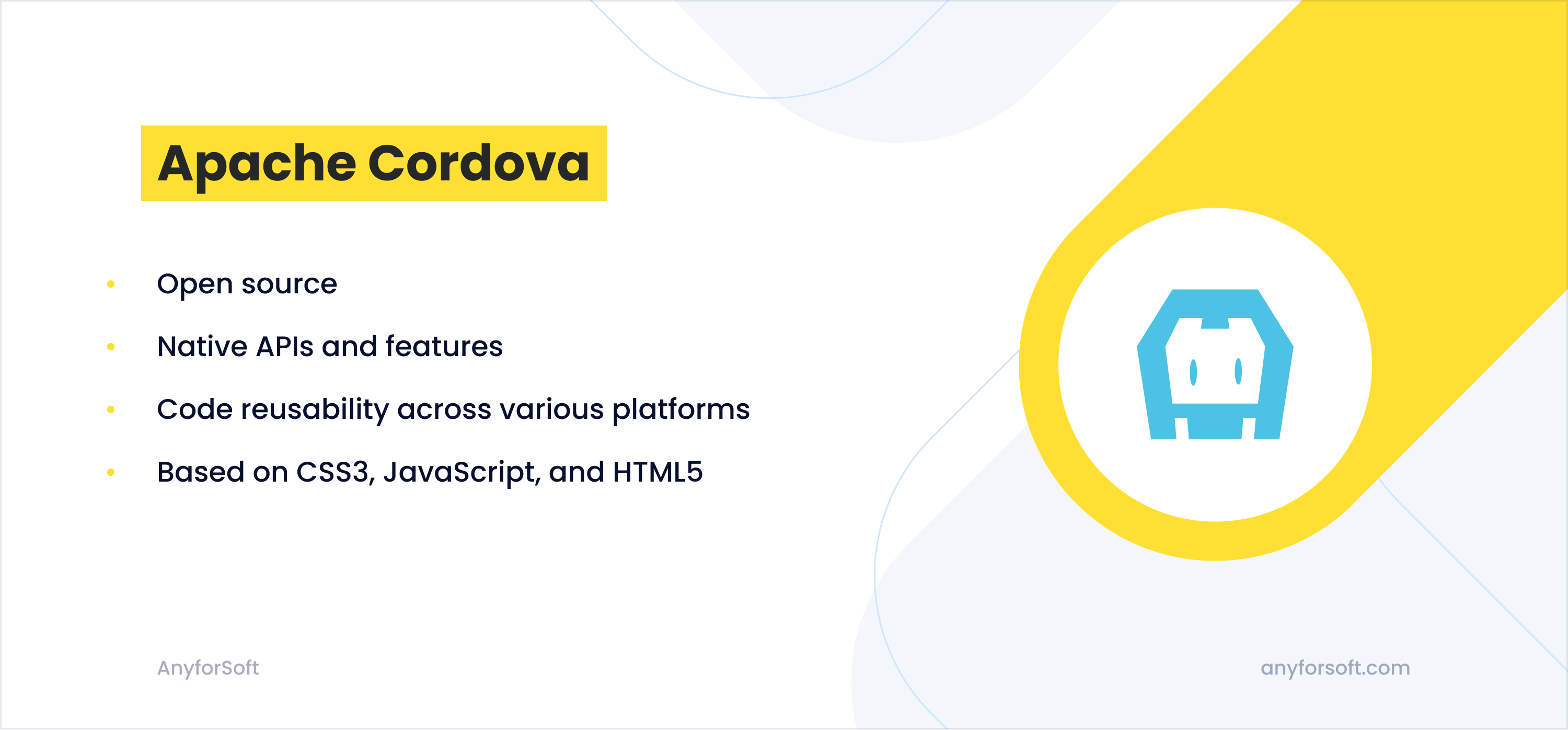
Another solution in our hybrid app framework comparison list is Apache Cordova. Apache Cordova is a free open-source framework working with widespread technologies such as HTML, CSS, and JavaScript. The framework supports native APIs and features, including a compass, microphone, file system, and accelerator. The majority of the code created in Apache Cordova can be reused, which facilitates hybrid mobile app development.
Cordova offers a vast selection of plugins for most features and platforms. They can transform JavaScript code into native code to ensure native-like performance.
Apps built with Apache Cordova: Pacifica, FanReact, Gudog, SparkChess, Buildr, Graded.
Pros of Apache Cordova
- Code reusability across various platforms.
- Cordova supports native APIs and features, enabling developers to build hybrid apps with close-to-native performance and look.
- The framework is well-documented and relatively easy to use.
- Cordova is based on CSS3, JavaScript, and HTML5—most developers know how to work with these technologies.
- Starting a new project is easy and quick.
Cons of Apache Cordova
- Setup and installation might take a while—some developers claim that Cordova is not user-friendly in that department.
- Some features that the framework offers require troubleshooting.
- Some plugins are outdated and unmaintained.
- Apache Cordova is not a perfect solution for enterprise-grade iOS and Android apps.
#7 Framework 7
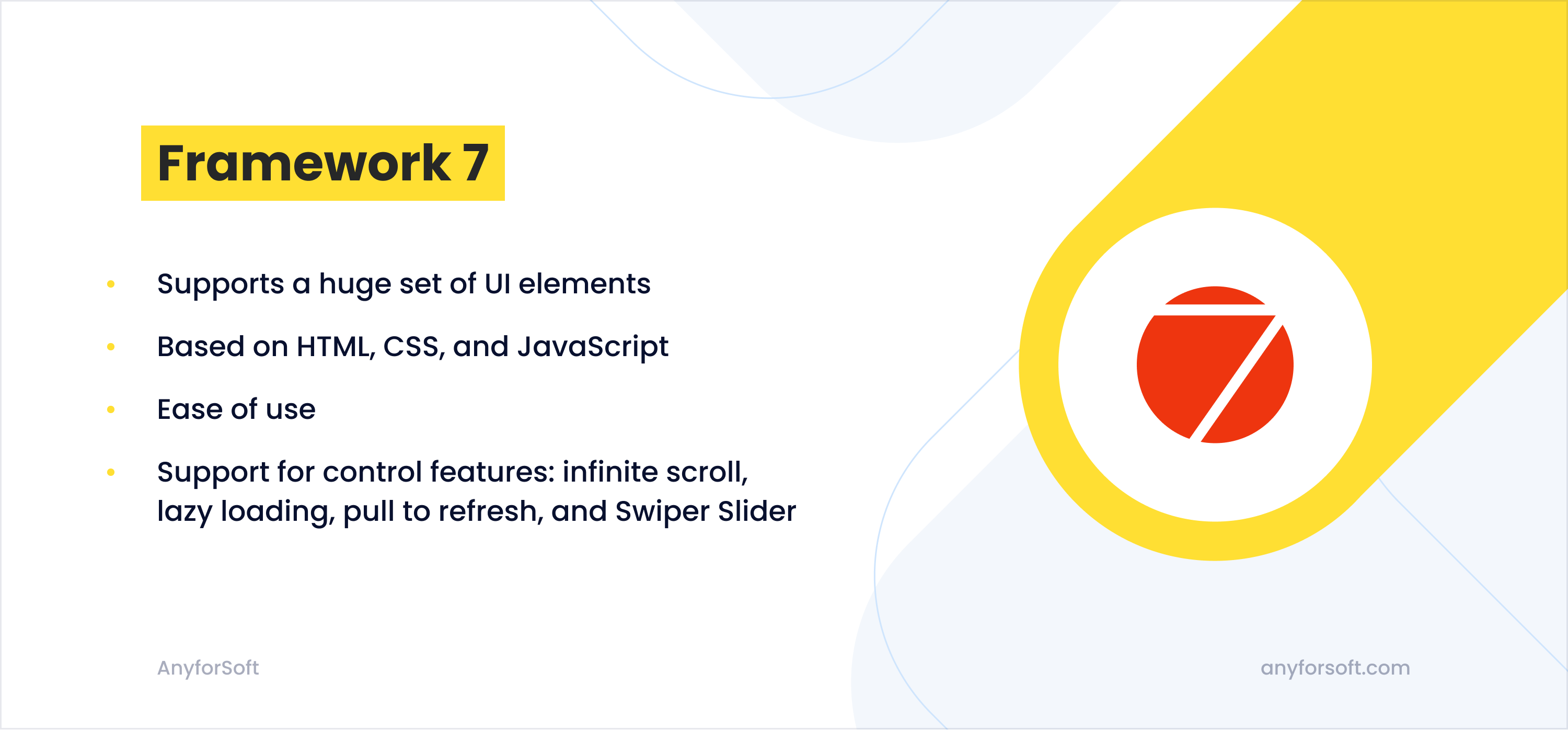
Framework 7 is a free open-source hybrid app development framework and a prototyping tool. One of its main advantages is that the framework supports a huge set of UI components, allowing developers to create progressive web apps and hybrid apps with native-like performance, look, and feel.
Framework 7 uses widespread technologies such as HTML, CSS, and JavaScript, so creating an app with this framework is in many ways similar to creating websites.
Framework 7 comes with the vanilla JavaScript library along with the Vue.js, React, and Svelte components. It facilitates hybrid app development by bringing structured data, components-syntax, and data bindings with the power and simplicity of React, Vue.js, and Svelte.
Apps built with Framework 7: Rabbit Mail, EasyQuick Shop, AvatarGen, GoDial, Fitness Pets, My Shopper.
Want to build your hybrid application but don’t have an in-house team? AnyforSoft has you covered! We offer a big set of cross-platform mobile app development services for your business. More than 10 years of development experience allows us to develop any solutions, from mobile wallets to M-commerce applications to cloud-based software.
Pros of Framework 7
- Framework 7 is easy to use and has comprehensive documentation.
- A vast selection of native UI components is available out of the box.
- The framework supports many control features, including infinite scroll, lazy loading, pull to refresh, and Swiper Slider.
- Framework 7 is user-friendly and can be utilized even by beginner developers.
- Setup and installation are fast and easy.
Cons of Framework 7
- Some plugins conflict with each other and crash (it often happens with the Swiper Slider plugin mentioned above).
- Framework 7 is built around the iOS operating system, so developers might face issues when optimizing code for Android devices.
- The framework updates frequently, and while it is a good thing in terms of security and performance, keeping your app updated with the latest Framework 7 version can be challenging.
- Some claim that the framework is relatively difficult to customize.
#8 Kendo UI
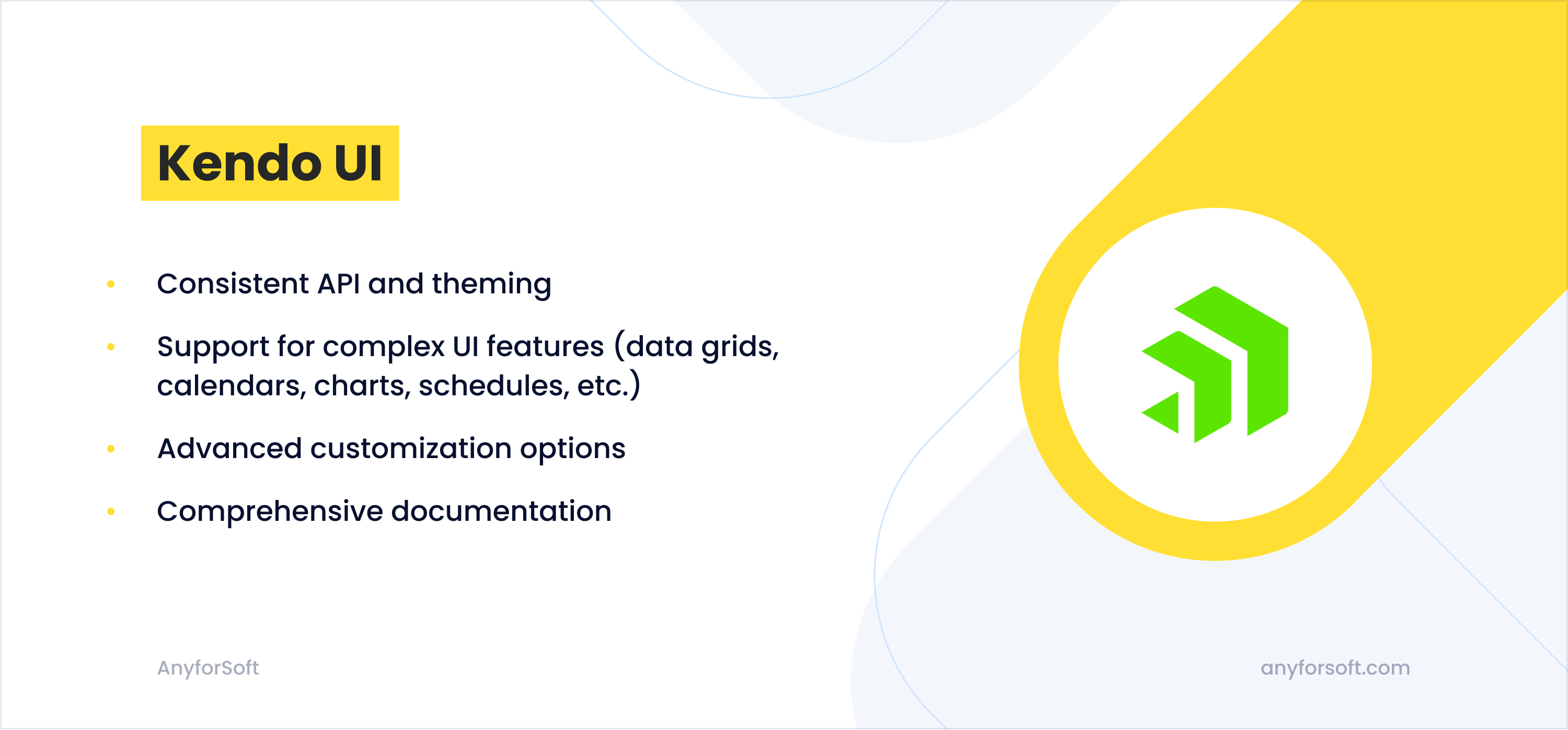
Kendo UI is a hybrid mobile app development toolkit by Telerik. Basically, it is a set of four JavaScript UI libraries natively built for Angular, jQuery, Vue, and React. Each set is built with consistent API and theming, enabling developers to create hybrid apps with responsive, modern, and easily accessible user interfaces.
Kendo UI boasts over a hundred ready-made UI components, support for complex UI features (data grids, calendars, charts, schedules, etc.), high performance, and great customer support.
Apps built with Kendo UI: DubiCars, RealDash, Mad Cars.
Pros of Kendo UI
- Consistent API and theming, allowing for the creation of modern, easily accessible, and attractive UIs.
- Great customer support and comprehensive documentation covering every aspect of this hybrid app development framework.
- A wide range of UI components out-of-the-box that facilitate cross-platform app development.
- Kendo UI offers plenty of customization options, enabling developers to build unique mobile and web applications.
Cons of Kendo UI
- Price is pretty expensive (some also claim that the pricing system is not clear).
- Some components come with too many configurations, making it difficult to use them properly.
- Kendo UI has a steep learning curve.
- While documentation is thorough, developers complain that it lacks code examples when it comes to more creative usage patterns.
#9 NativeScript

Another hybrid app framework in our list is NativeScript. With NativeScript one can develop native/hybrid apps using JavaScript or another programming language that transpile to JavaScript: TypeScript, Angular, and so on.
The framework allows developers to build truly native apps with one codebase. The apps will use the same APIs as if they were developed with XCode or Android Studio. In addition to that, software creators can integrate their applications with third-party libraries from Cocoapods, Android Arsenal, Maven, and npm.js without wrappers.
Apps built with NativeScript: ActiveLook, Aura CO2, Chess Clock, Daily Nanny, eLsi Station, Grainfather Community.
Pros of NativeScript
- NativeScript is a unique framework that enables you to create a native mobile application with one codebase.
- App integration with third-party libraries doesn’t require the use of wrappers.
- NativeScript allows you to get platform-native UIs without WebView, dramatically accelerating performance.
- The framework offers detailed documentation and has a great community.
Cons of NativeScript
- CLI Setup might be difficult.
- Some plugins are buggy and poorly maintained.
- Developers need to know native Android and iOS APIs to access device hardware and other platform-specific functionality.
- NativeScript doesn’t have built-in support for HTML and DOM, which requires the use and implementation of different UI tools instead.
#10 Ext JS
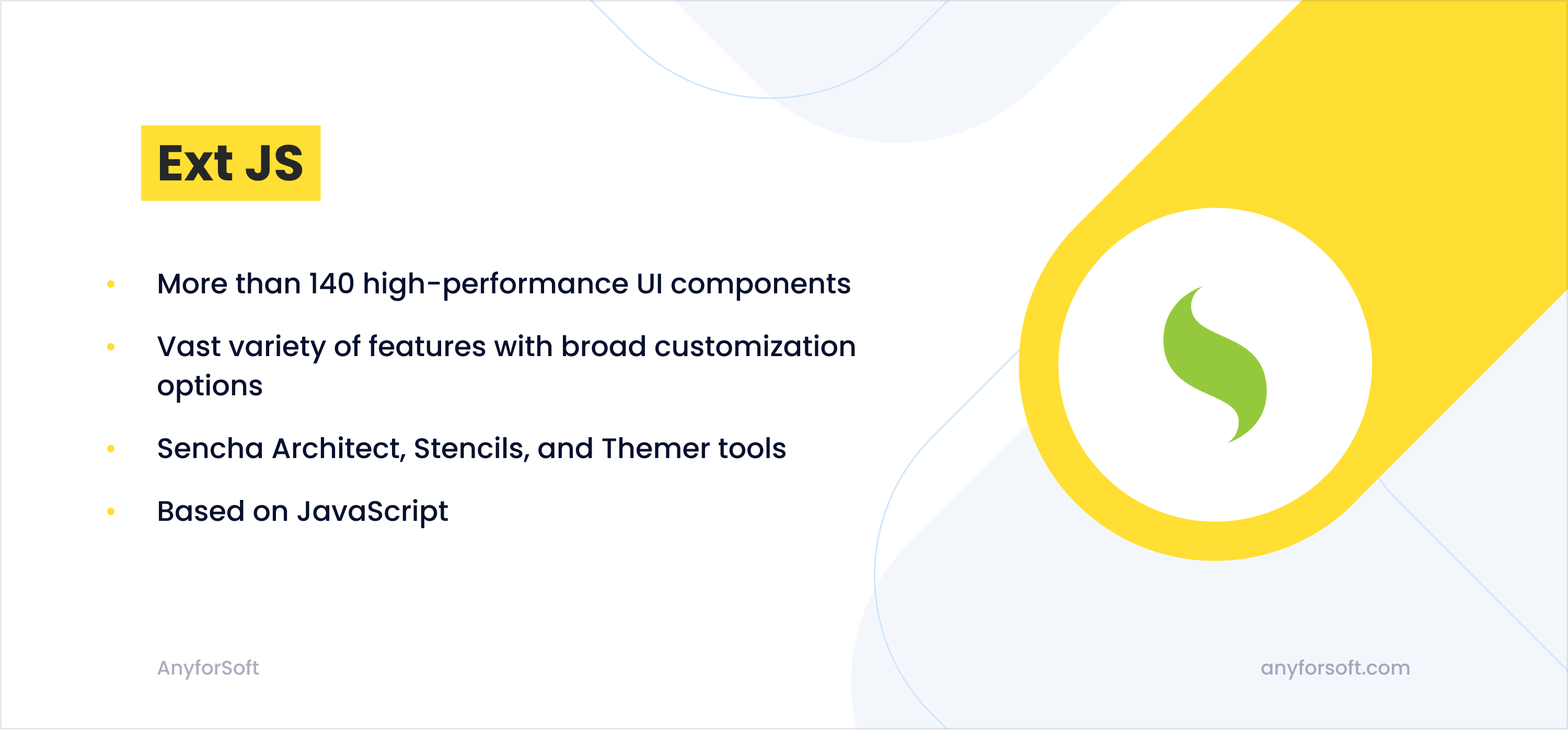
Ext JS is one of the top hybrid app frameworks for building data-intensive cross-platform mobile and web apps with JavaScript. It comes with more than 140 high-performance UI components, including grids, a D3 adapter, an HTML5 calendar, lists, forms, menus, and other elements. It also offers pre-integrated tools such as Sencha Architect, Stencils, and Themer that enable developers to build applications using drag-and-drop features and quickly create eye-catching user interfaces.
Ext JS is a great solution for building complex and feature-rich mobile and web apps.
Apps built with Ext JS: Xero, LastPass, MailOnline, Impact, Wrike, Salesforce.
Pros of Ext JS
- Ext JS provides a vast variety of features with broad customization options.
- Ext JS can be integrated with numerous other hybrid mobile app development frameworks.
- The framework offers Sencha Architect, Stencils, and Themer built-in tools that facilitate hybrid mobile application development.
- Ext JS features a flexible layout manager to help organize the display of app content across multiple browsers, devices, and screen sizes and thus perfectly adapt the app.
Cons of Ext JS
- The price is pretty expensive.
- It might take a while to learn how to use the tools Ext JS offers.
- Documentation lacks examples and some features are not well documented.
- Customer support could be better (especially for users of the free version).
#11 Mobile Angular UI
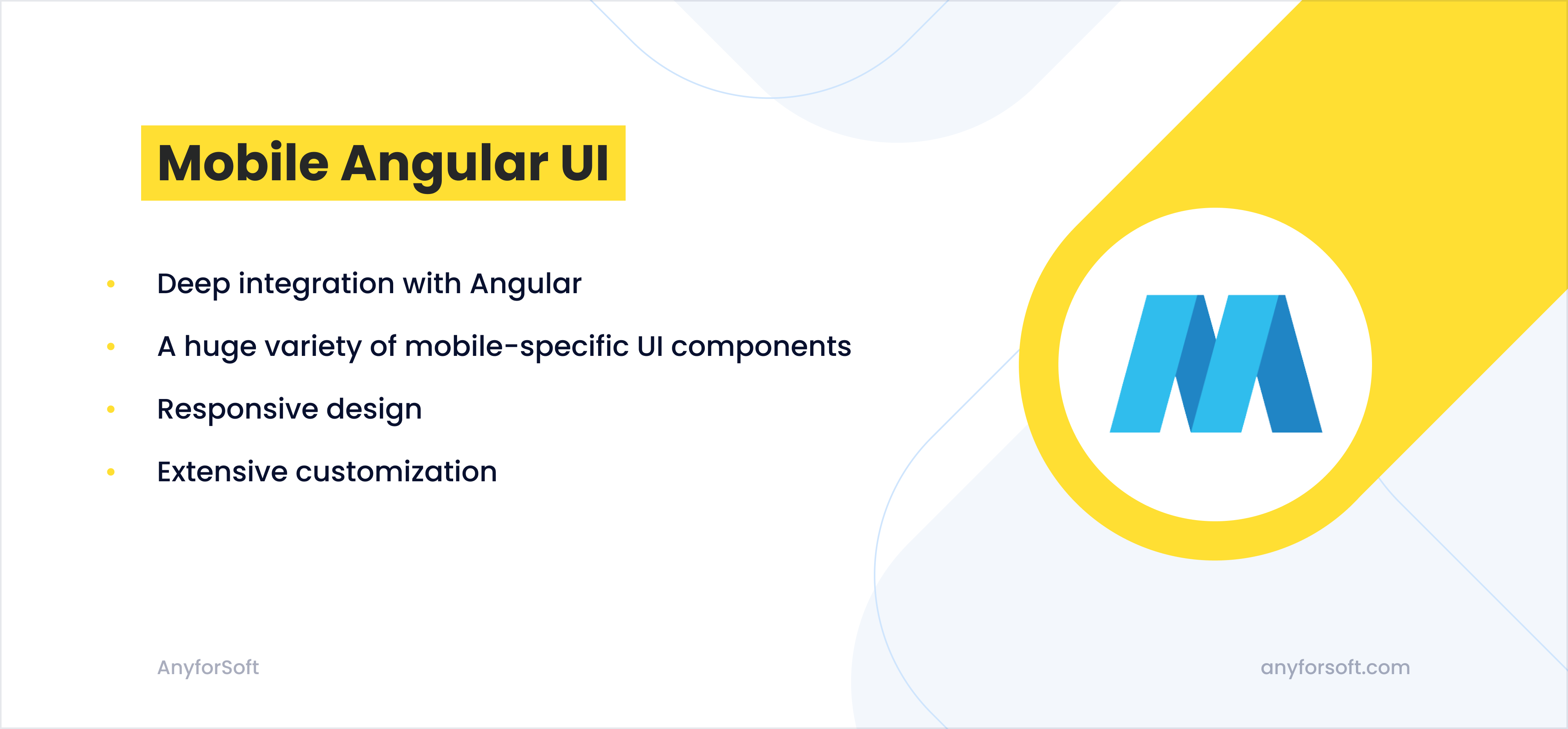
Mobile Angular UI is one of the most popular hybrid frameworks that combines the simplicity and flexibility of Angular with mobile-specific UI components and interactions, including switches, overlays, sidebars, and scrollable areas. It supports responsive design principles and provides touch-optimized components for creating intuitive interfaces. The framework simplifies development by integrating seamlessly with Angular, enabling developers to leverage existing skills in web development.
Apps built with Mobile Angular UI: iKeyBox, Hotelier News, Guezz it, Good Doctor.
Pros of Mobile Angular UI:
- Mobile Angular UI integrates deeply with Angular, allowing developers to access the features of this framework, including data binding, dependency injection, and MVC architecture.
- The cross-platform framework supports a huge set of mobile-specific UI components (overlays, sidebars, switches, scrollable areas, and navbars) that enhance the user experience.
- As one of the best frameworks for hybrid app development, Mobile Angular UI supports responsive design principles, ensuring that applications adapt well to various screen sizes and orientations.
- The framework offers extensive customization capabilities.
Cons of Mobile Angular UI:
- Mobile Angular UI has a steep learning curve.
- The framework has limited access to native device features (developers often have to leverage additional plugins to access them).
- This is not the best hybrid app framework in terms of performance. When facing complex animations or intensive computations, apps built with Mobile Angular UI may lag.
- Ensuring compatibility across different mobile browsers and versions can be challenging.
#12 jQuery Mobile
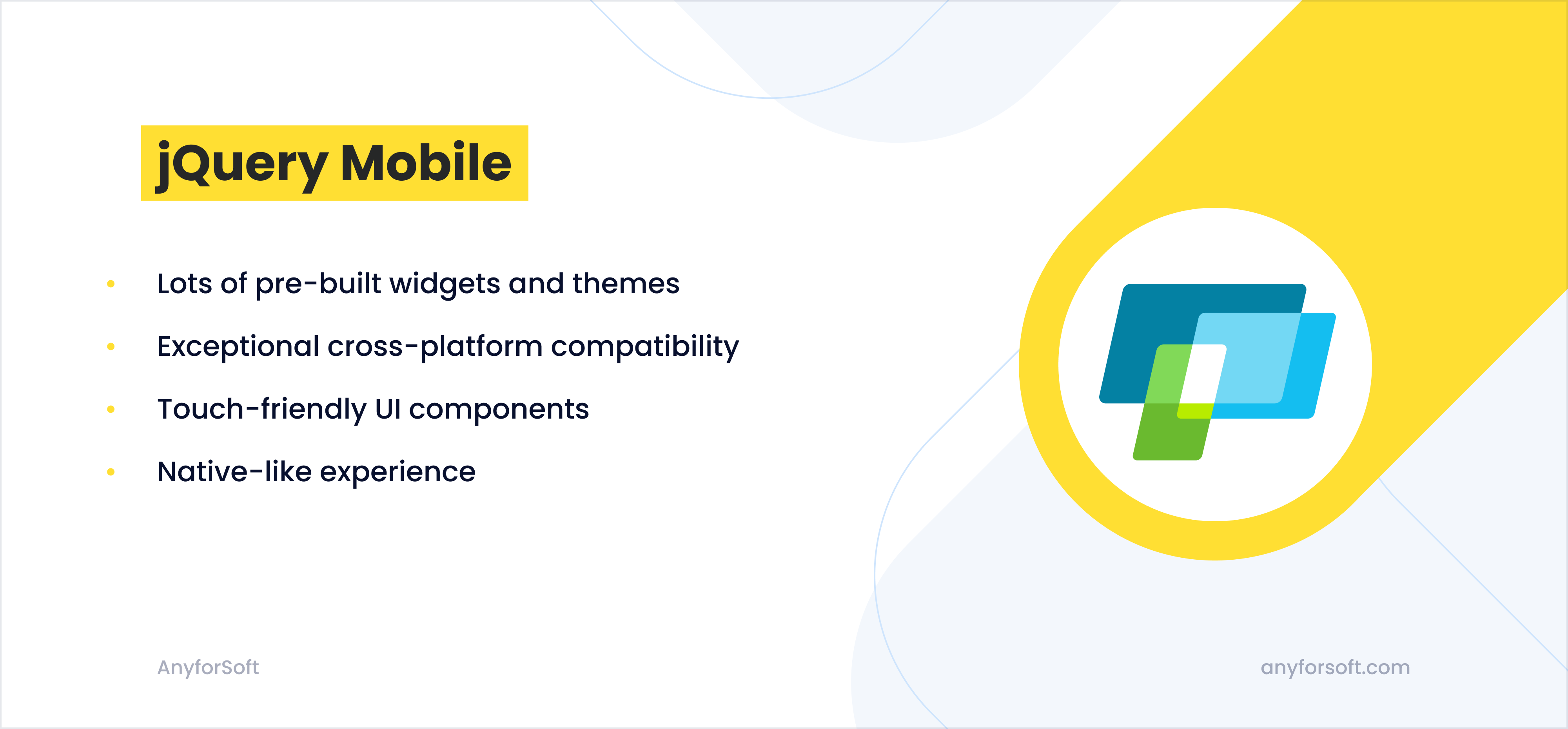
jQuery Mobile is an HTML5-based user interface system designed to make responsive websites and apps accessible on every device, be it a smartphone, tablet, or desktop. This cross-platform development framework provides a rich set of touch-optimized UI components and widgets such as buttons, lists, forms, navigation bars, dialogs, and popups. These components are designed to enhance user interactions on touchscreens, providing a native-like experience.
Apps built with Mobile Angular UI: My Tracks, National Geographic Education Mobile Site, United Nations Refugee Agency (UNHCR) Mobile Site.
Pros of jQuery Mobile:
- jQuery Mobile allows developers to create mobile-friendly websites and web applications that work seamlessly across different platforms and devices.
- This framework for hybrid mobile app creation simplifies mobile UI design with pre-built widgets and themes, making it accessible for developers to create consistent and attractive interfaces quickly.
- It offers touch-friendly UI components like buttons, sliders, and panels, enhancing the user experience on touchscreen devices.
- Developers familiar with jQuery can leverage their existing skills and knowledge, as jQuery Mobile builds upon the jQuery framework.
Cons of jQuery Mobile:
- The framework may not perform as efficiently as native mobile apps, especially for complex applications or animations, due to its reliance on web technologies.
- Customizing jQuery Mobile beyond its default themes and components may require a steep learning curve or extensive CSS knowledge.
- .NET interaction with jQuery Mobile is one of the biggest troubles, especially with the update panels.
How to choose the best hybrid mobile app framework for your needs
Now that you have an extensive list of frameworks, the next step is to choose the right solution for your business. To get complete information on each listed framework, we recommend visiting their websites while also reading reviews on specialized portals (G2 and alike). In addition to that, consider the following factors:
1. Price. Many of the listed frameworks are available for free. However, the free version’s functionality is usually limited. To gain access to all features, you will have to pay a certain monthly or yearly fee. Make sure that you can afford a specific framework before choosing it.
2. Your target platform. Another thing to consider is the platform you target. If you want to develop a solution for a very specific system (such as watchOS, for instance), ensure that the framework of your choice provides functionality for that.
3. Tech stack. While many frameworks are based on widespread technologies and programming languages, some require knowledge of rare technologies. For example, Flutter uses its own programming language called Dart, which is a combination of Java and Kotlin. Finding developers that have experience with Dart might be challenging.
4. Native-like features. Ask yourself what native-like features your app will require. Maybe your solution needs access to a phone camera to function properly? Or perhaps, it needs a microphone? Based on that, choose the framework that fits your needs.
As a team that cares about the success of our customers, we hope that this article has been of value to you and will eventually help you choose the best hybrid mobile app framework for your business. In case you need assistance, AnyforSoft is always here for you. We can help you choose the right development platform and develop a solution that will meet your business requirements.
Contact us today and tell us more about the hybrid app you aim to build.
FAQs
A hybrid mobile app is an application that combines the elements of a native mobile app and a web app. It’s built with popular hybrid mobile app frameworks and technologies such as HTML, CSS, and JavaScript, providing cross-platform functionality. Hybrid mobile applications are often designed to mimic the look and feel of native solutions, making them almost indistinguishable from them. Apart from cross-platform compatibility, hybrid mobile apps boasts access to device features, good performance, and ease of deployment.
A hybrid mobile app is an application that combines the elements of a native mobile app and a web app. It’s built with popular hybrid mobile app frameworks and technologies such as HTML, CSS, and JavaScript, providing cross-platform functionality. Hybrid mobile applications are often designed to mimic the look and feel of native solutions, making them almost indistinguishable from them. Apart from cross-platform compatibility, hybrid mobile apps boasts access to device features, good performance, and ease of deployment.
Hybrid frameworks are highly popular, as they allow developers to create a cross-platform application utilizing a single code base. By leveraging frameworks like Flutter, React Native, Ionic, Xamarin, and others, software engineers are able to write code once and then deploy it across multiple platforms. This dramatically decreases development time and cost.
When you build native apps, however, the case is different, as you have to write separate app codes for each individual platform, leveraging different frameworks and programming languages. Obviously, this requires more time and expertise, resulting in more expensive development.
Hybrid frameworks are highly popular, as they allow developers to create a cross-platform application utilizing a single code base. By leveraging frameworks like Flutter, React Native, Ionic, Xamarin, and others, software engineers are able to write code once and then deploy it across multiple platforms. This dramatically decreases development time and cost. When you build native apps, however, the case is different, as you have to write separate app codes for each individual platform, leveraging different frameworks and programming languages. Obviously, this requires more time and expertise, resulting in more expensive development.
